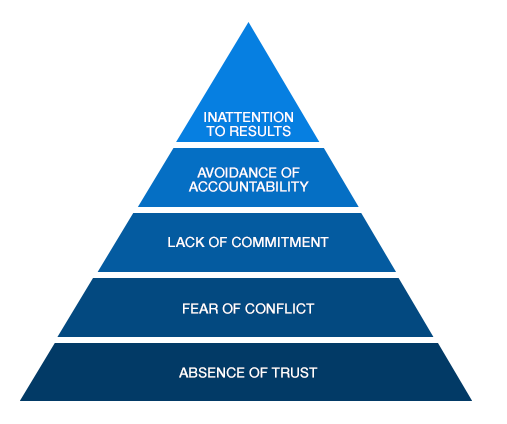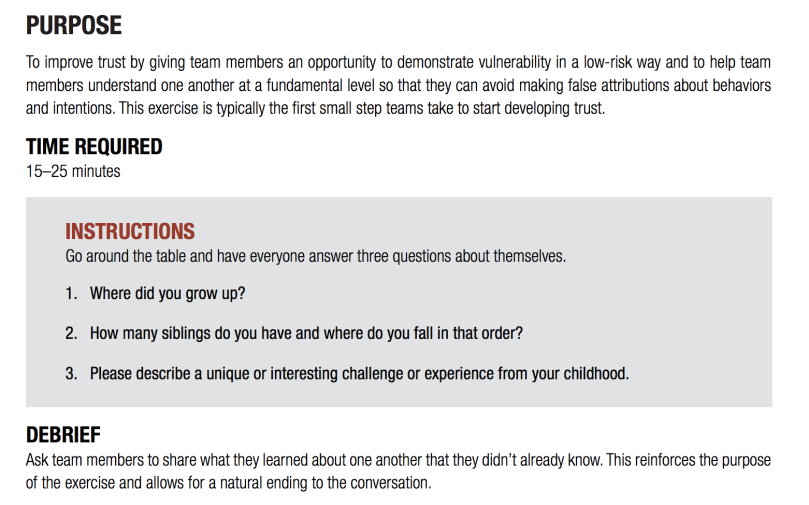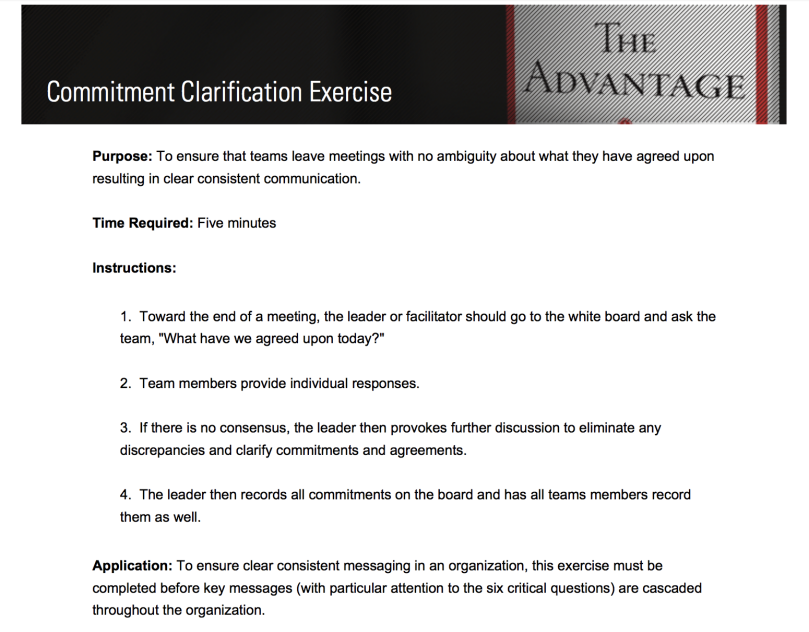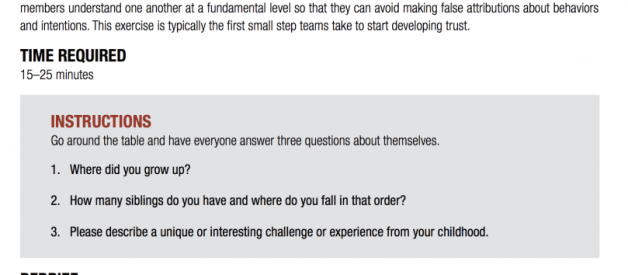You might have come across ?The Five Dysfunctions of a Team?. Patrick Lencioni, a consultant and speaker, wrote this seminal business book back in 2002. In this book, Lencioni identified the common root causes behind teams and companies underperforming:

Dysfunction #1: Absence of Trust:
The fear of being vulnerable with team members prevents the building of trust within the team.
Dysfunction #2: Fear of Conflict:
The desire to preserve artificial harmony stifles the occurrence of productive ideological conflict.
Dysfunction #3: Lack of Commitment:
The lack of clarity or buy-in prevents team members from making decisions they will stick to.
Dysfunction #4: Avoidance of Accountability:
The need to avoid interpersonal discomfort prevents team members from holding one another accountable.
Dysfunction #5: Inattention to Results:
The pursuit of individual goals and personal status erodes the focus on collective success.
Fig. 1 ? Patrick Lencioni?s ?The Five Dysfunctions of a Team? ? Taken from: https://www.tablegroup.com/books/dysfunctions
I recently read Lencioni?s followup book to ?The Five Dysfunctions?; ?Overcoming The Five Dysfunctions of a Team? is all about how to best solve common team dysfunctions. There a number of things one can do to overcome the different team dysfunctions that Lencioni identified all those years ago:
1. Building trust
Lencioni stresses the importance of trust: ?no quality or characteristic is more important than trust.? Trust and vulnerability are closely interlinked, as Lencioni explains. Vulnerability-based trust comes from people not being afraid to admit the truth about themselves.
People being open and honest with themselves and each other, instead of wasting time and energy on politics. Building up this level of trust is by no means an easy feat or one off exercise. In contrast, it?s best to start small ? with The Personal Histories Exercise, for example and continue maintaining trust.

Fig. 2 ? Patrick Lencioni?s ?The Personal Histories Exercise? ? Taken from: https://www.tablegroup.com/imo/media/doc/AdvantagePersonal_Histories_Excercise(4).pdf
2. Mastering conflict
Mastering conflict comes back to vulnerability-base trust, according to Lencioni. He explains that ?When people who don?t trust one another engage in debate, they?re trying to win the argument.? In contrast, when vulnerability-based trust exist, team members say everything to each other that needs to be said and things don?t need to be discussed further behind closed doors.
Let?s make no mistake about it; conflict is supposed to feel a bit uncomfortable. Lencioni explains that if team members ?never pushing one another outside of their emotional comfort zones during discussions, then it?s extremely likely that they?re not making the best decisions for the organization.?
Conflict Profiling is a great way to understand where you and your colleagues sit on the Conflict Continuum (see Fig. 3 below). What?s your appetite for healthy conflict? How does your appetite compare to Joe or Kathy?s on the team? Once you?ve figured out the different conflict profiles on the team and understand the differences, the best thing is to just talk about it within the team.
For example, what to me might feel like a good discussion, might to you feel like we?re butting heads ? Once we understand our individual conflict profiles, we?re in a much better position to talk about how we best have a constructive discussion. One could, for example, agree that when we ask what might sound like difficult questions, these questions aren?t meant as personal attacks. Instead, these questions are only being asked because we want the best for the team, the business or the product.

Fig. 3 ? Patrick Lencioni?s ?Conflict Continuum? ? Taken from: http://www.corporategames.com/whats-new/leadership-training/good-leaders-can-use-conflict-build-great-team/
3. Achieving commitment
The next dysfunction to overcome is the lack of commitment by team members. Lencioni makes the point that ?commitment is not consensus.? There seems to be this misconception that everybody needs to agree intellectually on a decision, and that you?re bound for failure if you don?t ? Lencioni argues the opposite: ?Waiting for everyone on a team to agree intellectually on a decision is a good recipe for mediocrity, delay, and frustration.?

I totally agree with Lencioni?s points about most meetings being boring due to a lack of conflict. As counterintuitive as this may sound, I think we can all think of at least one regular meeting where we all just turn up and go through the mentions. However, meetings don?t have to be dull and unproductive.
In the words of Lencioni: ?Team members can indeed become engaged in a meeting, but only when there is something at stake, a conflict worth caring about.? There is an important role for team leaders here, since they?re in great position to give team members a reason to care at the beginning of a discussion or a meeting.
In contrast, commitment is about ?Buy-In?, defying a lack of consensus. It?s about getting a group of individuals to buy into a decision especially when they don?t naturally agree. Lencioni identifies two critical steps to achieve buy-in for a decision:
- Extract and explore team ideas ? Good leaders drive team commitment by first extracting every possible, idea, opinion and perspective from the team. This is why I believe that good product leaders and managers need to be able to facilitate these open ended conversations or brainstorming sessions, especially since product people need to be able to influence without authority.
- Stick your neck out and decide ? Once you?re comfortable that all options and perspectives have been explored, then the team leader needs to step up and make a decision. I know from experience that this is easier said than done, because our instinct is to try and get everybody to be happy about your decision. However, it?s unlikely that you?ll please everyone with your decision and that?s fine, as long as you explain the decision and why you made it ? especially to those people with an opposite view. Lencioni refers to this process as ?disagree and commit? and suggests the ?Commitment Clarification? exercise to ensure that everyone in the team is clear about what exactly has been decided in the meeting or conversation (see Fig. 4 below).

Fig. 4 ? Patrick Lencioni?s ?Commitment Clarification? ? Taken from: https://www.tablegroup.com/imo/media/doc/Commitment%20Clarification%20Exercise.pdf
4. Embracing accountability
Are you prepared to ?enter the danger?? It?s the key question that comes out of Lencioni?s chapter about embracing accountability. Lencioni defines accountability as ?the willingness of team members to remind one another when they aren?t living up to the performance standards of the group.? In an ideal world, this kind of accountability should be peer-to-peer and require the team leader to hold people accountable.
In reality though, and for peer to peer accountability to become the norm, the team leader needs to be prepared to call an individual on their behaviour or performance, and thus ?enter the danger?. I totally agree with Lencioni where he observes that most leaders he knows ?have a far easier time holding people accountable for their results than they do for behavioural issues.? This can be problematic because behavioural problems almost always precede results.
As daunting as it may seem at first, it is possible to have a constructive conversation about their behaviour. In my experience, the key is to be very specific about the behavioural issues that you?ve observed and describe the impact that these issues have caused (I highly recommend reading ?Radical Candor? by Kim Scott if you?re keen to learn more about this topic).
The next step would be to run what Lencioni call a ?Team Effectiveness Exercise?:

Fig. 5 ? Patrick Lencioni?s ?Team Effectiveness Exercise? ? Taken from: https://www.tablegroup.com/imo/media/doc/AdvantageTeamEffectiveness_Exercise(8).pdf
5. Focusing on results
Lencioni raises the questions about what makes it so hard to stay focused on results? He answers the questions by talking about self-interest and self-preservation. To avoid these human pitfalls, Lencioni suggest the team picking one goal the whole team can focus on:
?On strong teams, no one is happy until everyone is succeeding, because that?s the only way to achieve the collective results of the group. Of course, this implies that individual egos are less important than team achievements.?
In this scenario, the team will know that it?s being successful when it accomplishes the results it sets out to achieve. This requires team members to prioritise team results over their individual or departmental needs. To stay focused, teams must publicly clarify their desired results and keep them visible.
Main learning point: ?Overcoming The Five Dysfunctions of a Team? is a valuable resource for anyone interested in creating or being part of effective teams. In addition to studying the factors of successful teams, the book offers a number of helpful exercises to overcome these dysfunctions.
Related links for further learning:
- https://www.tablegroup.com/books/dysfunctions
- https://www.tablegroup.com/books/overcoming-the-five-dysfunctions-a-field-guide
- https://www.tablegroup.com/imo/media/doc/AdvantagePersonal_Histories_Excercise(4).pdf
- http://www.corporategames.com/whats-new/leadership-training/good-leaders-can-use-conflict-build-great-team/
- https://www.truity.com/blog/personality-type-conflict-style
- https://www.tablegroup.com/imo/media/doc/Commitment%20Clarification%20Exercise.pdf
- https://www.tablegroup.com/imo/media/doc/AdvantageCascading_Communication_Exercise(6).pdf


